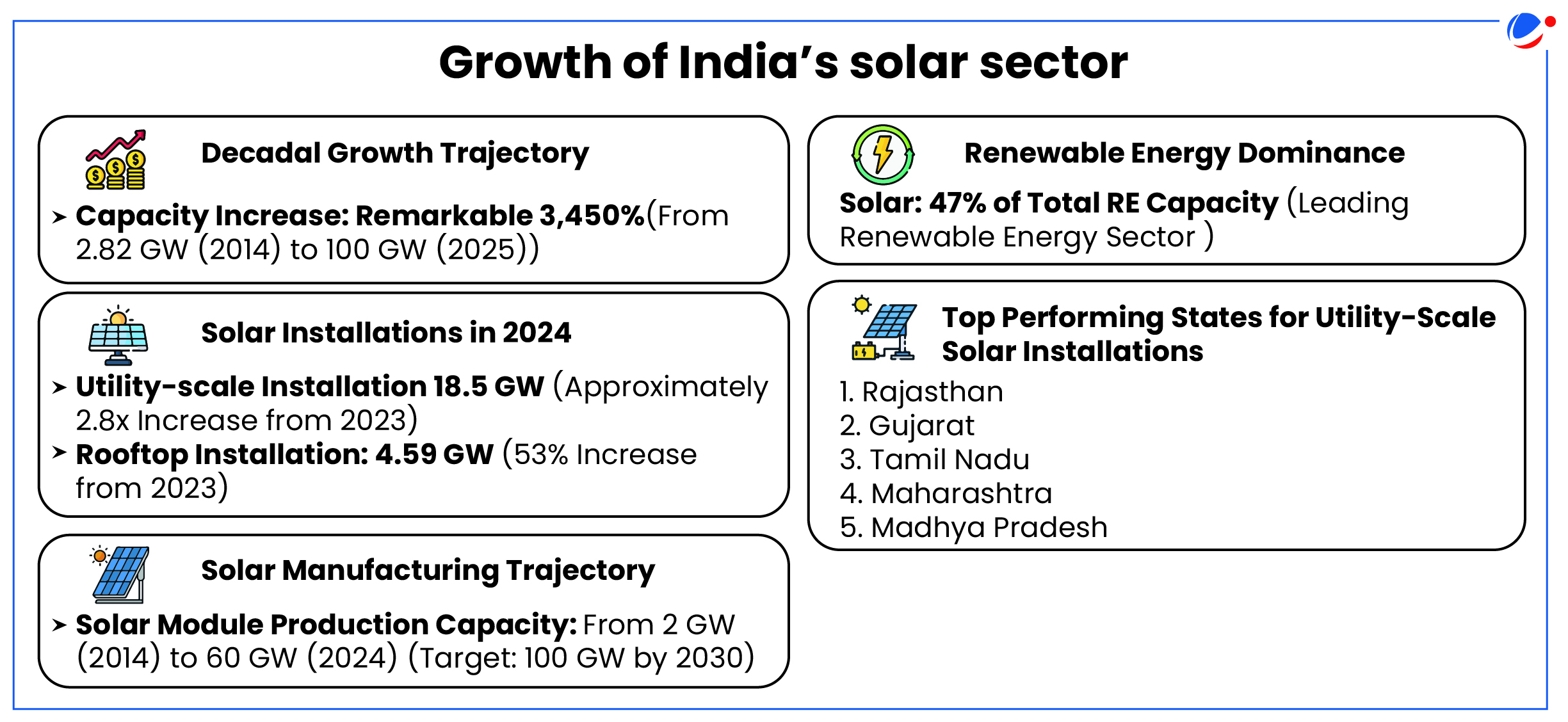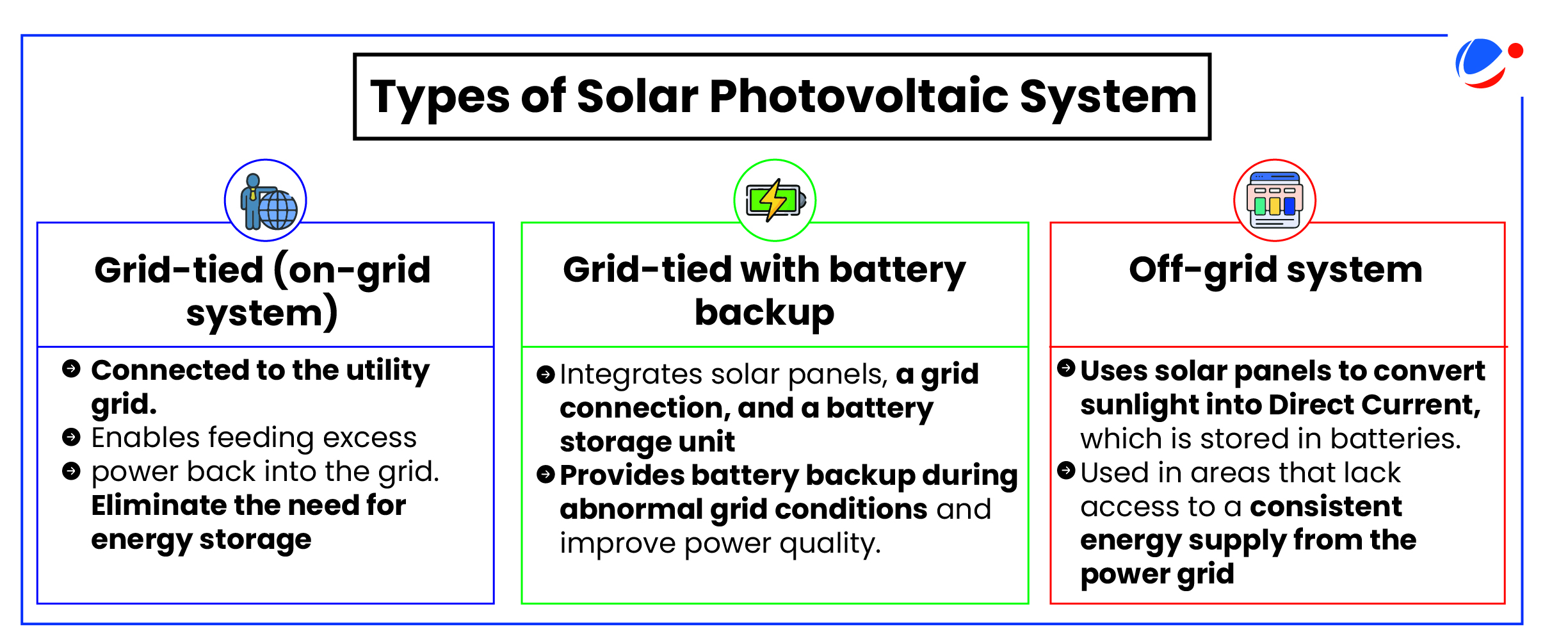Why in the News?
India has achieved a historic milestone by surpassing 100 GW of installed solar power capacity.
More on the news
- As of January, 2025, India's total solar capacity installed stands at 100.33 GW with remarkable growth trajectory (see infographic).
- 84.10 GW is under implementation and an additional 47.49 GW under tendering.
- India's also witnessed growth in hybrid and round-the-clock (RTC) renewable energy projects.
- Projects generating 64.67 GW are under implementation and tendered, bringing the grand total of solar and hybrid projects to 296.59 GW.

About Solar Energy
- Solar power is energy from the Sun that is converted into thermal or electrical energy.
- This is done through-
- Photovoltaic cells: which is utilized in solar panels made of different semiconductor materials.
- Concentrating solar-thermal power (CSP) systems: which use mirrors to reflect and concentrate sunlight onto receivers that collect solar energy and convert it to heat.

- Potential of Solar Energy in India: 748 GW assuming 3% of the waste land area to be covered by Solar PV modules [National Institute of Solar Energy (NISE)]
- Significance of Solar energy in India
- Achieving India's climate targets: In accordance with the Paris climate agreement, India's Nationally Determined Contributions (NDCs) include cutting emissions intensity by 45% and achieving 50% non-fossil fuel capacity by 2030.
- Further, India aims to achieve 500 GW of non-fossil fuel-based energy capacity by 2030 (Panchamrit announced at UNFCCC COP26).
- Fulfill future Energy Needs: India's energy use is 3 times the global average (India Energy Outlook 2021) and is expected to drive 25% of global demand growth over next 20 years.
- Rural Electrification: Solar energy can support off-grid power generation with fast capacity expansion, benefiting remote areas.
- Achieving India's climate targets: In accordance with the Paris climate agreement, India's Nationally Determined Contributions (NDCs) include cutting emissions intensity by 45% and achieving 50% non-fossil fuel capacity by 2030.
Factors behind growth of Solar Energy in India
- Geographical Advantage: India receives abundant solar radiation, with ~300 sunny days per year and an average of 4-7 kWh/m²/day, making most regions ideal for solar power generation.
- Government Schemes:
- Pradhan Mantri Kisan Urja Suraksha evam Utthaan Mahabhiyan (PM-KUSUM) Scheme targeting 30.8 GW solar power in agricultural sector.
- PM Surya Ghar: Muft Bijli Yojana enabling nearly 10.09 lakh rooftop solar installations (March 2025), establishment of National Institute of Solar Energy etc.
- Financial support and encouraging investment: India has allowed 100% of foreign direct investment (FDI) through the automated process.
- Further, Interstate transmission system (ISTS) fees are waived for solar and wind energy sales across states for projects that are scheduled to be put into service by June 30, 2025.
- Boost RE consumption: Renewable Purchase Obligation (RPO) trajectory has been announced till 2029-30 including separate RPO for Decentralized Renewable Energy.
- Indigenous manufacturing of solar components: Through initiatives like Solar Park Scheme, Production Linked Incentive (PLI) Scheme under National Programme on High Efficiency Solar PV Modules, etc.
- Consumer awareness: Bureau of Energy Efficiency (BEE) launched Standards and Labeling (S&L) programs for both grid-connected solar inverters and solar photovoltaic (PV) modules in March 2024, aiming to help consumers make informed choices and improve energy efficiency.
- Building infrastructure: Under the Green Energy Corridor Scheme, the government is laying new transmission lines and creating new sub-station capacity for evacuation of renewable power.
- International Cooperation and Leadership: Initiatives like International Solar alliance, put India at the forefront of investing in clean energy technologies, by increasing energy access, guaranteeing energy security, and accelerating the energy transition among its member nations.
- Further, Indo-German Solar Energy Partnership (IGSP) is developing market forces while introducing enabling mechanisms and facilitating investments in rooftop PV systems.
Issues constricting in further advancement of solar energy in India
- Land Acquisition: Solar can need 300 times as much space as nuclear energy (Economic Survey 2023-24).
- Extremely large-scale solar farms require huge areas of land often conflicting with food security and environmental interests.
- Infrastructure constraints: Grid integration and energy storage, pose challenges to scalability due to technological limitations, high costs etc.
- Environmental concerns: Extraction of minerals needed for Solar, particularly Lithium, Cobalt, Nickel, and some rare earth minerals, leave large scars in the landscape and require substantial water, releasing about 15 tonnes of CO2 per tonne of mineral. (Economic Survey 2023-24)
- Challenges to domestic manufacturing: Lack of R&D, modern development facilities, and manufacturing infrastructure impact the development of solar panels, equipment, and inverters in India leading to increased dependence on imports
- Policy and Regulatory Hurdles: Complex regulatory frameworks and inconsistent policies across states affect project implementation.
- Delays in approvals and land clearances reduce the pace of solar energy deployment.
- Other issues: High initial Investment; waste problem as solar panels have to be replaced every couple of decades; etc.
Way forward
- Modernize grid: Invest in smart grid technologies and develop localized microgrids in rural areas.
- Increase land-use efficiency: Promote agrivoltaics and increase development of floating solar panels on reservoirs, irrigation canals, and water bodies to minimize land use conflicts.
- Policy Simplification: Harmonizing state and central policies can help streamline project approvals and incentivize investments.
- Technological Innovations: Advancements in solar panel efficiency, energy storage (batteries), and hybrid systems (solar-wind) can boost adoption.
- The integration of artificial intelligence (AI) and the Internet of Things (IoT) in solar systems can optimize energy production and consumption.
- Circular economy approach: Establish a robust recycling ecosystem for solar panels and batteries to recover critical materials and reduce the need for new mineral extraction.
- Boost Domestic Manufacturing: Encouraging local production of solar cells, modules, and storage solutions through programs like "Make in India" can help boost the solar production further.



